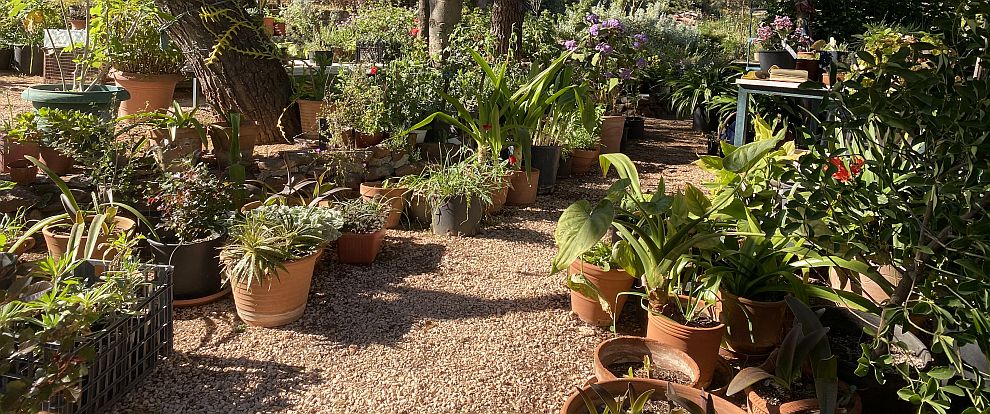
Mediterranean Garden Society

Mediterranean Garden Society

The photograph at the top of this page shows the Nursery in April (Photo Lucinda Willan)
The nursery lies at the working heart of Sparoza, for it is here that plants are raised for the garden. Plants are occasionally purchased, or received as gifts from members, but most of the new planting at Sparoza uses species that have already been tested in the garden for their ability to do well in its hot, dry conditions and have then been propagated and raised in its own nursery. Seeds and cuttings collected in the garden or offered by members are also nurtured here for subsequent trial in the garden.
The nursery is situated to the west of the house. It includes a fenced propagation area, secure against stray dogs and wandering tortoises, partially roofed with split bamboo matting for shade. This area also contains the frames constructed by Peter Dinning in which seedlings and cuttings are sheltered until they are ready to be moved out into the open. 'The open' in this case means the outer part of the nursery, shaded by a pine, a Judas tree and a Brachychiton and terraced with low stone walls, where the propagated plants are grown on in neat rows of plastic pots.
Much of the potting compost used in the nursery is generated from the compost bins at Sparoza.
Twice a year, in autumn and in spring, a plant exchange is organised when plants surplus to the needs of the garden are made available to MGS members in return for a small donation.
click on map to enlarge
click here to download as a pdf
1. Tradescantia pallida
2. Pelargonium quercifolium
3. Pelargonium
4. Salvia hierosolymitana
5. Malvastrum lateritium
6. Portulacaria afra
7. Barleria cristata
8. Quercus agrifolia
9. Rosa sp.
10. Origanum dictamnus
11. Santolina viridis
12. Sphaeralcea ambiguata
13. Penstemon eatonii
14. Cheirolophus canariensis
15. Salvia interrupta x candelabrum
16. Helichrysum orientalis
17. Rosa sp.
18. Parkinsonia aculeata
19. Artemisia arborescens
20. Centaurea spinosa
21. Cotyledon orbiculata
22. Convolvulus cneorum
23. Morus alba
24. Sonchus palmensis
26. Pelargonium fragrans
27. Teucrium marum
28. Ballota acetabulosa
29. Salvia desoleana
30. Seseli rigidum
31. Asperula taygetea
32. Freesia laxa
33. Thymbra calostachya
34. Pterocephalus multiflorus
35. Fibigia linarioides
36. Stachys ionica
37. Campanula carpatha
38. Senecio fulgens
39. Dianthus serratifolius
40. Salvia argentea
41. Centaurea akamantis
42. Origanum acutidens
43. Stachys parolinii
44. Centaurea akamantis
45. Petromarula pinnata
46. Thymbra spicata
47. Phlomis fruticosa
48. Silene fruticosa
49. Thymus sp.
50. Dianthus squarrosus
51. Thymus mastichina
52. Stachys sp.
53. Centranthus ruber
54. Tetraclinis articulata
55. Agave americana 'Variegata'
56. Cercis siliquastrum
57. Ornithogalum longibracteatum or caudatum
58. Austrocylindropuntia subulata
59. Bulbine fruticans
60. Rosmarinus repens
62. Climbing ?
62. Drosanthemum sp.
63. Senecio tamoides
64. Pinus halepensis
65. Yucca elephantipes
66. Pinus pinea
67. Olea europea
68. Cupressus sempervirens
THE MEDITERRANEAN GARDEN is the registered trademark of The Mediterranean Garden Society in the European Union, Australia, and the United States of America